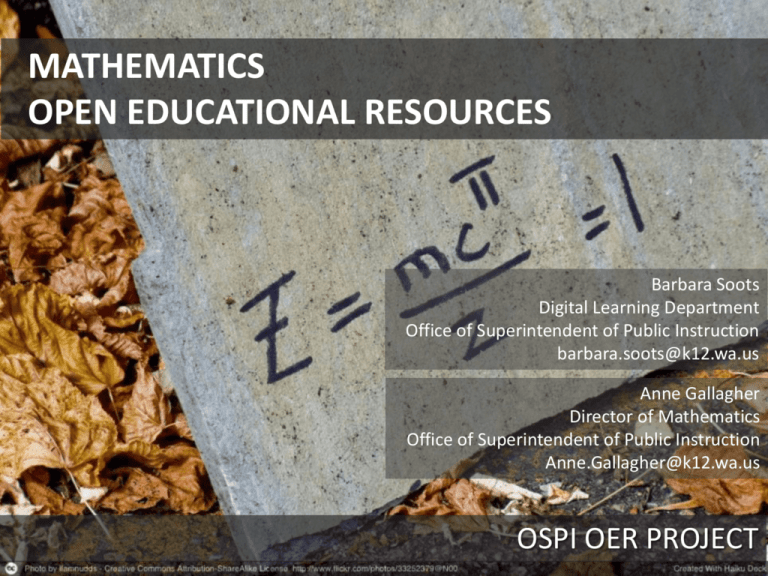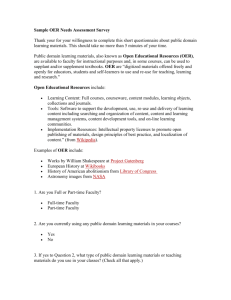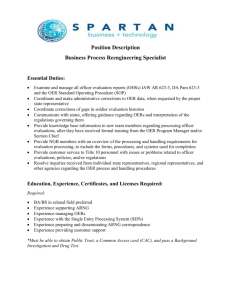
MATHEMATICS
OPEN EDUCATIONAL RESOURCES
Barbara Soots
Digital Learning Department
Office of Superintendent of Public Instruction
barbara.soots@k12.wa.us
Anne Gallagher
Director of Mathematics
Office of Superintendent of Public Instruction
Anne.Gallagher@k12.wa.us
OSPI OER PROJECT
OER ARE…
resources that reside in the public domain or have been released
under an intellectual property license that permits their free use and
re-purposing by others.
CC BY-SA
Beyond definitions
http://www.flickr.com/photos/opensourceway/6554315179/
THE 5 Rs OF OER
Reuse — copy verbatim
Redistribute — share with others
Revise — adapt and edit
Remix — combine resources
Retain — make, own, & control copies
Photo by kungfubonanza – CC BY NC SA
License http://www.flickr.com/photos/78638228@N00
OPEN LICENSING
Traditional
Copyright Alone
Open License
Public
Domain
All Rights
Reserved
Some
Rights
Reserved
No Rights
Reserved
• Tell people how their material can be used
• Create a pool of material that can be shared and reused legally
• Enable a culture of sharing
Adapted from Creative Commons in the Classroom – J. Goates
http://www.slideshare.net/Jessicacoates/creative-commons-in-the-classroom-2013#/
CREATIVE COMMONS LICENSES
FREE VS. OPEN
CC BY Gratis Koffie by Thomas van de Weerd https://www.flickr.com/photos/thms/
CC CY SA Free by Gisela Giardino https://www.flickr.com/photos/gi/
HOW CAN YOU USE OER?
Gather image and audio resources
Access free books in the public domain
Display video and audio lectures
Experience interactive simulations
Explore game-based learning programs
Build and share lesson plans
Download and print a textbook
Access full online course curricula
Participate in open professional learning programs
Photo by designsbykari – CC BY NC
http://www.flickr.com/photos/43726999@N06
OER CAN HELP EDUCATORS…
•
•
•
•
•
Save money
Reduce prep time and improve materials
Keep up to date, discover innovative materials and engage students
Learn from others
Solve legal issues – no more worrying about copyright!
UX Help by Betsy Webber, CC BY, http://www.flickr.com/photos/betsyweber/3307988944/
CRICOS No. 00213J
WASHINGTON
K-12 OER PROJECT
“The legislature finds the state's
recent adoption of Common
Core K-12 standards provides an
opportunity to develop a library
of high-quality, openly licensed
K-12 courseware that is aligned
with these standards.”
CC BY Washington State Capitol – CIMG2000 by Piutus
https://www.flickr.com/photos/alreadytaken/
USING OER - POTENTIAL ROADBLOCKS
Finding target resources
Student/teacher access at school and home
District policies that don’t recognize OER as an option
Evaluating quality and alignment
CC BY Rhino Roadblock by Chris Ingrassia
http://www.flickr.com/photos/andryone/445139454/in/photostream/
REVIEWING OER
Help educators select high quality materials
Provide information for materials adoptions
Identify gaps in CCSS alignment
11
CC BY NC SA
apples by msr
http://www.flickr.com/photos/msr/448820990/
CRITERIA FOR OER REVIEW
UNLIMITED ACCESS AND PERMISSIONS
OVERVIEW OF RESOURCES
CK–12: Algebra (second edition)
CK–12: Geometry Concepts
CK–12: Geometry Honors Concepts
Curriki: Algebra 1
Curriki: Geometry
Georgia Virtual Academy: Algebra 1
Mathematics Vision Project: Integrated Math 1
Mathematics Vision Project: Integrated Math 2 2
National Repository of Online Courses: Algebra 1
New York State Common Core Mathematics Curriculum: Algebra 1
New York State Common Core Mathematics Curriculum: Geometry
Saylor.org: Algebra 1 (select units)
Saylor.org: Geometry
Utah Open High School: Algebra 1
EVALUATION TIMEFRAME
•
•
•
Math: 9-10 hours per curriculum
Each reviewer assigned 3-4 math courses
30-40 hours total effort
14
HOW TO EVALUATE QUALITY?
CCSS Worksheet
IMET Rubric
EQuIP Rubrics
Achieve OER Rubrics
Reviewers Comments
CCSS – OER CURRICULUM
NWMC 10/11/13
Smarter Balanced Claims
Claim #1 – Concepts & Procedures
“Students can explain and apply mathematical concepts and interpret and carry
out mathematical procedures with precision and fluency.”
Claim #2 – Problem Solving
“Students can solve a range of complex well-posed problems in pure and applied
mathematics, making productive use of knowledge and problem solving strategies.”
Claim #3 – Communicating Reasoning
“Students can clearly and precisely construct viable arguments to support their
own reasoning and to critique the reasoning of others.”
Claim #4 – Modeling and Data Analysis
“Students can analyze complex, real-world scenarios and can construct and use
mathematical models to interpret and
solve
problems.”
NWMC
10/11/13
Standards for Mathematical Practice
Describes
mathematical
“Habits of Mind”
that students at
ALL grade levels
should develop
NWMC 10/11/13
• Establish Mathematics Goals to
Focus Learning
• Implement Tasks that Promote
Reasoning & Problem Solving
• Use and Connect Mathematical
Representations
• Facilitate Meaningful Mathematical
Discourse
• Pose Purposeful Questions
• Build Procedural Fluency from
Conceptual Understanding
• Support Productive Struggle in
Learning Mathematics
• Elicit and Use Evidence of Student
Thinking
NWMC 10/11/13
Samples of OER Curriculum
•
•
•
•
Engage NY
CK 12
Curriki
Mathematics
Vision Project
NWMC 10/11/13
+
Engage NY
This resource is ready to go, off the shelf. Ideally it would be adopted
as part of the whole series of Engage NY. Students would have
trouble adapting to the rigor of this material without a careful
development of the mathematics required in earlier grades. Engage
NY has raised the bar for other OER providers and for more
traditional textbook publishers. This is the Common Core
∆
• Each lesson has the mathematical practices that should be used but to
see the content standards, a teacher would have to go back to the
beginning of the module.
• Interactive features missing
• No interactive component
• Design with specific pacing and time per activity implies strict adherence
to following one lesson and practice exercise with another without
consideration of student understanding - One day per lesson with the
number of specific minutes per section.
NWMC 10/11/13
Engage NY Curriculum
Grade 5 Mathematics Module 2, Topic A, Lesson 1
Find the product of 451 x 8
Now find the product of 451 x 8 using a
different method
How can you use your strategies to help
you solve 4510 x 80?
NWMC 10/11/13
Claim 1
CONCEPTS AND PROCEDURES
Students can explain and apply mathematical
concepts and interpret and carry out
mathematical procedures with precision and
fluency.
Productive Struggle
Effective teaching of mathematics consistently provides students, individually
and collectively, with opportunities and supports to engage in productive
struggle as they grapple with mathematical ideas and relationships.
Principles to Action NCTM, pg 48
Flexible Thinking
Effective teaching of mathematics builds fluency with procedures on a
foundation of conceptual understanding so that students, over time, become
skillful in using procedures flexibly as they solve contextual and mathematical
problems.
Principles to Action NCTM, pg 42
NWMC 10/11/13
Engage NY
https://www.engageny.org/commoncore-curriculum
CK-12
have taught a traditional classroom for decades, and am reluctant to
+ Ichange.
Reviewing this Flexbook has opened me to possibilities in teaching
∆
and learning I had not fully considered. I applaud your efforts.
The ideal use of this resource is as a support resource to current curricula.
Some of the content presentations are much better than other materials on
the market. It would be best if the teacher using any of this material were
experienced, and had knowledge of the CCSS practice standards, as they are
now explicitly missing from the lessons. The resources available to teachers
are hard to find or navigate, even for those with a strong interest in a
technology driven curriculum.
No answer keys for problem sets.
No unit (chapter) assessments and very limited mid-unit assessments.
No number/symbol references to Common Core content standards in
lessons - many teachers are required to provide these connective numbers
to lesson objectives for district.
No reference at all to the CCSS Math Practices Just as important in our
district as the content standards.
NWMC 10/11/13
Flexbook – Algebra Expressions Pre-K – 7th (Grade 6)
https://ck12.org/book/Algebra-Explorations-Pre-K-throughGrade-7/section/8.9/
NWMC 10/11/13
Claim 3
Communicating Reasoning
Students can clearly and precisely construct
viable arguments to support their own
reasoning and critique the reasoning of others.
Meaningful Discourse
Effective teaching of mathematics facilitates discourse among students to
build shared understanding of mathematical ideas by analyzing and comparing
student approaches and arguments.
Principles to Action NCTM, pg 29
Opportunities for Discourse
Students who learn to articulate and justify their own mathematical ideas,
reason through their own and others’ mathematical explanations, and provide
a rationale for their answers develop a deep understanding that is critical to
their future success in mathematics and related fields.
Thinking Mathematically, pg 6
NWMC 10/11/13
CK-12
https://ck12.org/
Curikki
+•
Overall, I like the scenarios that the publisher uses to generate authentic
reasoning in the student. They are very well thought out and articulated.
• This resource would be most useful as a supplemental resource for a
seasoned teacher and would provide a great change of pace, and a
chance to see what math is required in real-world situations.
∆
I couldn't see myself using this curriculum as a replacement to my current
textbook. Some of the CCSS content is missing, and much of what is there is
not at the in-depth level required by CCSS
My main issue with the curriculum is the lack of procedural development by
the student.
No supplementary material for special needs learners
.
NWMC 10/11/13
What’s Your Angle, Pythagoras?
http://www.curriki.org/xwiki/bin/view/Coll_Group_GeometryBetaTesters/W
hatsYourAnglePythagoras_0?bc=;Coll_Group_GeometryBetaTesters.CurrikiG
eometryResources
NWMC 10/11/13
Claim 2
PROBLEM SOLVING
Students can solve a range of complex wellposed problems in pure and applied
mathematics, make productive use of
knowledge and problem solving strategies.
Rich Tasks
Effective teaching of mathematics engages students in solving and discussing
tasks that promote mathematical reasoning and problem solving and allow
multiple entry points and varied solution strategies.
Principles to Action NCTM, pg 17
Purposeful Questions
Effective teaching of mathematics uses purposeful questions to assess and
advance students’ reasoning and sense making about important mathematical
ideas and relationships.
Principles to Action NCTM, pg 35
NWMC 10/11/13
Curriki
http://www.curriki.org/welcome/res
ources-curricula/curriki-geometrycourse/
Math Visions Project
+
∆
• This curriculum is very good in my eyes. I like the
launch/explore/discuss protocol. These are clearly outlined in the
lesson plans for the instructor. They are thorough and well
planned. This protocol meets the "Practice-Content Connections"
with in the HSPC document section 5. The amount of practice is
nicely suited for the majority of students. The CCSS instructor
document is great
• Limited support for struggling/ELL students
• No technology/media
• No specific reference to the math practices in the lessons (or
the correlation documents)
NWMC 10/11/13
Module 4 Honors
Linear and Exponential Functions
NWMC 10/11/13
Claim 4
Modeling and Data Analysis
Students can analyze complex and real-world
scenarios and can construct and use
mathematical models to interpret and solve
problems.
• Modeling and data analysis are critical mathematical reasoning
needed in numerous career and jobs that are non-STEM.
• What is considered modeling?
– Simulations
– Visual models
– Tables, graphs, diagrams, charts, formulas/equations
Students can analyze relationships mathematically to draw
conclusions. They interpret their mathematical results in
the context of the situation and reflect on whether the
results make sense, possibly improving the model if it has
not served its purpose.
NWMC 10/11/13
Math Visions Project
HTTP://WWW.MATHEMATICSVISIO
NPROJECT.ORG/
NWMC 10/11/13
Top Resources - Math
Illustrative Mathematics Project
https://www.illustrativemathematics.org/
Takes available aligned to the CCSS that illustrate the standards. These tasks have
been vetted by leaders in the nation for alignment and quality.
Progression Documents
http://ime.math.arizona.edu/progressions/
These documents give the narrative or story of how the domains progress both in a
particular grade and through several grades.
Publishers Criteria
http://www.achievethecore.org/downloads/Math_Publishers_Criteria_K8_Summer_2012.pdf
Provides criteria for aligned materials to CCSS. Based on the two major evidencebased design principles of the CCSSM, focus and coherence, the document intends to
guide the work of publishers and curriculum developers, as well as states and school
districts, as they design, evaluate, and select materials or revise existing materials.
Inside Mathematics http://www.insidemathematics.org/index.php/home
Classroom examples and tools for innovative instruction, and videos of instructional
practices aligned to the CCSS.
NWMC 10/11/13
Top Resources – Big Picture
Achieve The Core
www.achievethecore.org
Resources included annotated tasks and lessons, professional development
resources, instructional practice guides, and the Materials Alignment Toolkit.
Assessment System Resources
www.smarterbalanced.org
Smarter Balanced Released Sample Items, Performance Tasks, Practice Test
Achieve
www.achieve.org
Multiple array of resources to support implementation of CCSS including
exemplar lessons and Equip Rubric and resources to implement the Equip
rubric.
Mathematics Assessment Project
http://map.mathshell.org/materials/index.php
The Mathematics Assessment Program (MAP) aims to bring to life the
Common Core State Standards (CCSSM and exemplify CCSSM in engaging
tasks, performance assessments and lessons grounded in formative
assessment.
NWMC 10/11/13
Common Core State Standards
DO NOT DEFINE:
– Curriculum
– How teachers are to teach
DO CREATE:
– A huge need for curriculum materials
– A huge need for teacher professional
development
– A huge opportunity for OER materials to meet
these needs
NWMC 10/11/13
OER REVIEW REPORT
https://digitallearning.k12.wa.us/oer/review/2014/report/summary.php
OER REVIEW REPORT ONLINE
Sparklines give quick
overview of resource
OER REVIEW REPORT ONLINE
Click on resource
title to get more in
depth review
information.
OER REVIEW REPORT ONLINE
Aggregated data
from reviewers
on how they
would use the
materials “as is”
and with
adaptations
NEXT STEPS
Follow us on Twitter: @waOSPI_OER
Apply or recruit for the 2015 OER Review
Applications accepted until November 14, 2014
Suggest OER for this review cycle
Take a look at the Southwest Washington
Common Core Mathematics Consortium’s OER
Algebra curriculum
Consider sending a district team to OER Summit
on December 8 at ESD 113
CC BY
Nooksack Stairs by Barbara Soots
STAY INVOLVED WITH THE OER PROJECT
Website: http://digitallearning.k12.wa.us/oer
Twitter: waOSPI_OER
OER Project Email: barbara.soots@k12.wa.us
Math Questions: anne.gallagher@k12.wa.us









